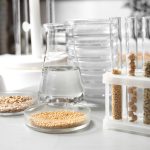SGS Crop Science Canada News: August 2023
• Organic Matter Quantification for Benchmarking
• Soil Health Measurements for Insight
• Bacterial Leaf Streak Testing for Seed Planning
• Manure Analysis to Enhance Soil
ORGANIC MATTER QUANTIFICATION FOR BENCHMARKING
Many are turning to testing carbon as an indicator of soil health, and as a measurement to baseline current levels to compare future results to after a management change such as reduced tillage or increased cover crops. Soil testing routinely reports Organic Matter, which is a % by dry weight of the soil, but in fact it is carbon that is measured to obtain this result. Testing by Walkley-Black is an accurate and high throughput method. It is also possible to measure by Loss on Ignition method for soils greater than 8% organic matter, essentially weighing the soil, combusting the organics, and then re-weighing.
New methods are being developed, that can accurately measure C without combustion or wet chemistry chemicals that create waste. SGS can help determine the best way of measuring soil carbon to meet your requirements.
SOIL HEALTH MEASUREMENTS FOR INSIGHT
Although there is more focus than ever before on the ‘healthiness’ of soil, and its role in regenerative crop production, there isn’t yet consensus on what measurements are the best indication of soil health. Given the variability of soil types and cropping systems, there is bound to be variability in the methods of measurement to best show a comparison of soil now versus future testing after improvements have been made. SGS provides testing to help benchmark soils and start collecting data on characteristics that are related to soil health. Beyond the traditional soil chemistry testing, biological and physical tests are also available. Carbon (CO2) Burst, Active Carbon, Soil Labile Amino Nitrogen, and Potentially Mineralizable Nitrogen are all tests that indicate the activity of soil microbiology. Physical tests include Bulk Density, Hydraulic Conductivity/Permeability, and Aggregate Stability. The former two are best tested on an intact core of soil, rather than a bulk composite. It should be noted though, that all of the above test methods show improved results as organic carbon/matter are increased. The organic fraction of soil contributes many benefits to both the biological population and the physical structure.
BACTERIAL LEAF STREAK TESTING FOR SEED PLANNING
Bacterial Leaf Streak (BLS) is a known seed borne pathogen resulting from infection of Xanthamonas translucens during the growing season. Infected wheat and barley may have significant yield reduction when weather patterns are favorable for bacteria replication and spread. Testing wheat and barley seed is new to western Canadian seed growers and farmers, with commercially available tests ready for the 2023 crop. As further research is conducted in the coming few years, much more will be learned about best management practices in-field and with seed selection. During the growing season watch out for streak-like lesions on the leaves. SGS can test live tissue in the summer, then seed post-harvest. We identify 3 of the most common species: X. translucens translucens, X. translucens undulosa, X. translucens cerealis. Our standard PCR test result will be reported as either detected, not detected or trace. For in-depth understanding, we also offer a quantitative test.
MANURE ANALYSIS TO ENHANCE SOIL
With current fertilizer costs, and more public pressure on reducing fertilizer use, it is important to account for the nutrient value within animal manures and composts. Collecting a representative sample to analyze for the N, ammonium-n, phosphate, and potash content allows for the crop producer to deduct these rates from the commercial fertilizer program, and combined with a soil test helps to target fields that are most in need of the nutrients. Knowing the nutrient value of a manure can also help calculate it’s relative dollar value for determining hauling distance or where it is traded or sold. The other benefit of manure that is more difficult to put a dollar value on is the organic matter content that improves soil physical properties and feeds the microbiological community, both of which help improve soil characteristics and crop production.





